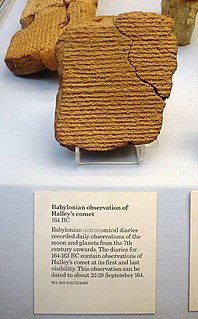Related Research Articles
Nabu-ri-man-nu was a Chaldean astronomer and mathematician.
Kidinnu was a Chaldean astronomer and mathematician. Strabo of Amaseia called him Kidenas, Pliny the Elder Cidenas, and Vettius Valens Kidynas.
Heraclides Ponticus was a Greek philosopher and astronomer who was born in Heraclea Pontica, now Karadeniz Ereğli, Turkey, and migrated to Athens. He is best remembered for proposing that the Earth rotates on its axis, from west to east, once every 24 hours. He is also hailed as the originator of the heliocentric theory, although this is doubted by some.

Mount Nemrut or Nemrud is a 2,134-metre-high (7,001 ft) mountain in southeastern Turkey, notable for the summit where a number of large statues are erected around what is assumed to be a royal tomb from the 1st century BC. It is one of the highest peaks in the east of the Taurus Mountains.

A solar symbol is a symbol representing the Sun. Common solar symbols include circles, crosses, and spirals. In religious iconography, personifications of the Sun or solar attributes are indicated by means of a halo or a radiate crown.

In classical antiquity, the seven classical planets or seven luminaries are the seven moving astronomical objects in the sky visible to the naked eye: the Moon, Mercury, Venus, the Sun, Mars, Jupiter, and Saturn. The word planet comes from two related Greek words, πλάνης planēs and πλανήτης planētēs, both with the original meaning of "wanderer", expressing the fact that these objects move across the celestial sphere relative to the fixed stars. Greek astronomers such as Geminus and Ptolemy often divided the seven planets into the Sun, the Moon, and the five planets.
Otto Eduard Neugebauer was an Austrian-American mathematician and historian of science who became known for his research on the history of astronomy and the other exact sciences as they were practiced in antiquity and the Middle Ages. By studying clay tablets, he discovered that the ancient Babylonians knew much more about mathematics and astronomy than had been previously realized. The National Academy of Sciences has called Neugebauer "the most original and productive scholar of the history of the exact sciences, perhaps of the history of science, of our age."
Seleucus of Seleucia was a Hellenistic astronomer and philosopher. Coming from Seleucia on the Tigris, Mesopotamia, the capital of the Seleucid Empire, or, alternatively, Seleukia on the Erythraean Sea, he is best known as a proponent of heliocentrism and for his theory of the origin of tides.
Vettius Valens was a 2nd-century Hellenistic astrologer, a somewhat younger contemporary of Claudius Ptolemy.

Babylonian astronomy was the study or recording of celestial objects during the early history of Mesopotamia.

Historically, astrological and astronomical symbols overlapped. Frequently used symbols include signs of the zodiac and classical planets. These originate from medieval Byzantine codices. Their current form is a product of the European Renaissance. Other symbols for astrological aspects are used in various astrological traditions.
A planet symbol is a graphical symbol used in astrology and astronomy to represent a classical planet or one of the modern planets. The symbols were also used in alchemy to represent the metals associated with the planets, and in calendars for their associated days. The use of these symbols derives from Classical Greco-Roman astronomy, though their current shapes are a development of the 16th century.

Jan Van Hoesen House is an early-18th-century house in New York State. Northeast on NY 66 of Hudson towards Chatham, just east of Claverack Creek, stands a vacant medieval-looking brick structure over the Dutch Acres Mobile Home Park. Like the Columbia County Historical Society's Luykas Van Alen House in Kinderhook, the steeply-pitched roof, parapet-gabled house is a rare surviving example of a type of rural house characteristic of the upper Hudson Valley in the first half of the 18th century. Van Hoesen House is located on Route 66, north of the City of Hudson.
Pamprepius was a philosopher and a pagan poet who rebelled against the Eastern Roman Emperor Zeno.
Papyrus Oxyrhynchus 235 is a horoscope written in Greek. It was discovered in Oxyrhynchus. The manuscript was written on papyrus in the form of a sheet. It is dated to the 1st century. Currently it is housed in the Cambridge University Library.
Jan Pieter Hogendijk is a Dutch mathematician and historian of science. Since 2005 he is professor of history of mathematics at the University of Utrecht.
Beth Van Hoesen, sometimes known as Beth Van Hoesen Adams, was an American artist who was best known for her prints and drawings of animals and botanical subjects.
The Monomoiria are the 360 individual degrees of the sky in Hellenistic astrology. They were each associated with particular planets, especially in traditions that influenced and were influenced by Paulus Alexandrinus's Eisagogika and Vettius Valens's Anthology.
Peter Van Hoesen, better known by his nom de guerreJames Sullivan, was an American Civil War veteran. Having deserted, he later enlisted on behalf of another individual and performed an act of valor for which he was awarded the Medal of Honor. However, the circumstances of his enrollment denied him his right to a service pension and the recognition of the award.

Antoinette Van Hoesen Wakeman, publishing also under the pen names Antoinette Van Hoesen and Antoinette Wakeman, was an American journalist who wrote for major Chicago newspapers as well as other periodicals across the country. She also founded periodicals in the fields of industrial education and fashion.
References
- Neugebauer, H. B; Van Hoesen, H. B. (1987). Greek Horoscopes, Volume 48. Philadelphia: The American Philosophical Society. p. 185. ISBN 9780871690487. LCCN 59-11559.